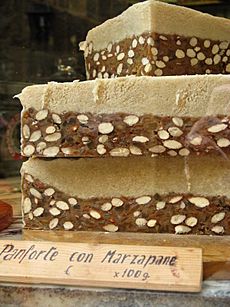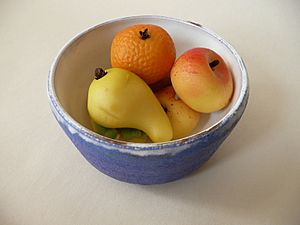Marzipan facts for kids
|
Marzipan moulded into marzipan pigs
|
|
| Alternative names | Marzapane, marchpane |
|---|---|
| Type | Confectionery |
| Main ingredients | Almond meal, sugar |
| Variations | Persipan, Frutta martorana |
Marzipan is a sweet treat made mostly from sugar (or honey) and ground almond meal (crushed almonds). Sometimes, a little almond oil or extract is added for extra flavor.
People often turn marzipan into fun sweets. You might find it covered in chocolate, or shaped into tiny, colorful fruits and vegetables. It's also used in biscuits or rolled out thin to cover cakes. This is very common in the UK for big fruitcakes, birthday cakes, and wedding cakes.
Sometimes, marzipan paste is used in baking, like in stollen bread or banket pastries. In some countries, people shape marzipan into small animal figures as a special treat for New Year's Day. It's also found in Tortell and some king cakes eaten during Carnival. Traditional Swedish princess cake often has a layer of pale green or pink marzipan on top.
Contents
Marzipan Around the World

Marzipan in Southern Europe
In Spain, marzipan is a traditional Christmas dessert. But in Toledo, where it was first written about in 1512, people eat it all year!
In Italy, especially in Palermo, marzipan (called marzapane) is often shaped and painted to look like fruit. These are called Frutta martorana. They are popular during Christmas and on Il Giorno dei Morti (All Souls' Day) on November 2. May 9 and 10 are also special marzipan days in Sicily.
In Portugal, nuns traditionally made marzipan (maçapão) into fruit shapes. It's a very popular sweet in the Algarve region. In places like Toledo, Spain, marzipan (mazapán) is shaped into simple animals. Sometimes, it's even filled with egg yolk and sugar.
In Greece and Cyprus, marzipan comes in many shapes and sizes. It is almost always left white. On the Aegean islands, white marzipan is a special wedding treat. It is served to guests at wedding parties. In Malta, marzipan fills the traditional Maltese Figolla treats for Easter.
Marzipan in Western and Central Europe
In the Netherlands and Belgium, marzipan figures are given as gifts to children on Saint Nicholas's Eve. In Germany, people often give marzipan shaped like a loaf of bread, called "Marzipanbrot," at Christmas. They also make small marzipan potatoes (Marzipankartoffeln). A traditional New Year's gift is a Glücksschwein, which means "lucky pig."
In Geneva, Switzerland, a special tradition for L'Escalade is smashing a chocolate cauldron. This cauldron is filled with marzipan vegetables. It remembers a time when a housewife supposedly saved the city from a siege by throwing boiling soup.
Marzipan in Northern Europe
In Denmark and Norway, it's common to eat marzipan pigs for Christmas. Marzipan shaped like eggs is popular for Easter. For New Year's Eve, they enjoy a cake called Kransekage.
In Tallinn, Estonia, the Maiasmokk café has a small museum. It teaches visitors about the history of marzipan and how it's made.
Marzipan in the Middle East
In the Middle East, marzipan is called لوزینه (lozina). It's flavored with orange-flower water and shaped into delicate roses and other flowers before being baked. Sometimes, marzipan can also be made from oatmeal or semolina. In Iran, marzipan fruit is a traditional treat for Passover. It's eaten instead of biscuits and cakes.
Marzipan in the Americas
Latin American cuisine got marzipan from Spain. It's known by the Castilian (Spanish) word mazapán. It's also traditionally eaten at Christmas. However, Latin American mazapán is usually made with peanuts instead of almonds.
Marzipan in Asia
In Goa, India, the Goan Catholic dish Mazpon uses cashew nuts instead of almonds. It's used to make Easter eggs and Christmas sweets. These Christmas sweets come in many shapes, like fruits, flowers, stars, trees, Santa, and snowmen. In the Philippines, marzipan came from Spain. Mazapán de pili is made from pili nuts.
The History of Marzipan
There are two main ideas about where marzipan first came from. They might both be true, as people traded and shared cooking ideas across the Mediterranean Sea for a long time. Some say marzipan started in China. From there, the recipe traveled to the Middle East and then to Europe through Al-Andalus (parts of Spain ruled by Muslims).
Marzipan from the Northeast Mediterranean
Many believe marzipan came to Eastern Europe through the Turks. In Turkish, it's called badem ezmesi. It was famously made in Edirne. But there's a friendly debate between Hungary and Italy about its true origin. In Sicily, Italy, it was known as panis martius or marzapane in 1193, meaning "March Bread."
Marzipan became a special treat in the port cities of the Hanseatic League. The cities of Lübeck in Germany and Tallinn in Estonia are very proud of their marzipan history. For example, Lübeck Marzipan has a special protected status. Makers like Niederegger in Lübeck promise their marzipan has at least two-thirds almonds by weight. This makes it very high quality. The city of Königsberg in East Prussia was also famous for its unique marzipan. Königsberg marzipan is still a special type in Germany. It has a golden-brown surface and sometimes a marmalade center.
Marzipan from the Iberian Peninsula

Another possible origin is Spain, which was once called Al-Andalus. In Toledo, around 850-900 AD (or more likely 1150 AD during the time of Alfonso VII), this sweet was called Postre Regio. There are also mentions in The Book of One Thousand and One Nights of an almond paste eaten during Ramadan.
Mazapán is Toledo's most famous dessert, often made for Christmas. It also has a special protected status. The rules say that almonds must make up at least 50% of the total weight. This follows the guidelines of the Mazapán de Toledo council. Another idea supporting this origin is the strong tradition of turrón in Spain. Turrón is another almond-based Christmas sweet.
In the U.S., marzipan isn't officially defined. But it usually has more sugar compared to almonds than almond paste. For example, one brand's marzipan has 28% almonds, while its almond paste has 45% almonds. However, in Sweden and Finland, "almond paste" means a marzipan with 50% ground almonds, which is much higher quality than regular marzipan. In Germany, Lübeck Marzipan is known for its quality, containing 66% almonds. The original handmade Mozartkugeln chocolates are made with green pistachio marzipan.
Types of Marzipan
Persipan is a similar product, but it's less expensive. Instead of almonds, it uses apricot or peach kernels. Many sweets sold as marzipan are made from cheaper ingredients, like soy paste and almond essence. To check if marzipan is real, special tests can tell if it's made from almonds or other things. German marzipan is made by grinding whole almonds with sugar and partly drying the paste. French marzipan, called 'massepain', is made by mixing ground almonds with sugar syrup. Some marzipan is flavored with rosewater. Spanish marzipan is made without bitter almonds. You can also find sugar-free marzipan, where sugar is replaced with other sweeteners like maltitol.
What's in a Name?
The German name "marzipan" has largely replaced the old English name marchpane. Both names seem to mean "March bread." (The word marchpane appears in Shakespeare's play Romeo and Juliet.) The word marzapane is found earlier in Italian than in other languages. The word "pan" means "bread" in Romance languages. One idea is that it comes from the Latin words "martius panis," meaning "bread of March."
However, the exact origin of the word is not fully clear. For example, the Italian word might come from the Latin words "Massa" (from Greek Μάζα "Maza") meaning pastry, and "Pan" meaning bread. This can be seen in the Portuguese maçapão and old Spanish mazapán. Another idea from the Oxford English Dictionary is that "marzipan" might come from Martaban, a city in Myanmar famous for its jars.
The Royal Spanish Academy suggests the Spanish word mazapán comes from the Arabic word pičmáṭ, which came from the Greek παξαμάδιον.
Another idea is that the name comes from the Arabic mawthābān, meaning "king who sits still." This Arabic word, changed to matapanus in Latin, was used for a Venetian coin showing Christ the King sitting on a throne. These coins were kept in fancy boxes. Around the 15th century, when the coins were no longer used, the boxes became decorative containers for fancy sweets. Marzipan, the famous almond-flavored sweet, started to be stored in these boxes in the 16th century. So, it might have been named after the box it was kept in.
If marzipan really came from Persia, the name might come from Marzban. In Persian, Marzban means "border guardian." This was a title for military leaders in charge of border areas in the Sassanid Empire of Persia between the 3rd and 7th centuries.
How Marzipan is Made
To make marzipan, raw almonds are first cleaned. This is done by sifting them, using air to separate them, and other machines. Then, the almonds are put in hot water, just below boiling, for about five minutes. This process is called blanching. It helps loosen the almond skins. The skins are then removed by passing the almonds through special rotating machines. This step also helps reduce a natural chemical called hydrogen cyanide and adds water to the almonds.
After blanching, the almonds are cooled. Then, they are roughly chopped and ground with up to 35% sugar to make almond flour. This almond flour mixture is then roasted and cooled. After that, more sugar (sucrose) and sometimes a binding agent like starch syrup are added. Once mixed, the marzipan can be molded into any shape!
Marzipan needs to be kept in an airtight container. This stops it from getting hard and dry. It should also be kept away from direct light. This helps prevent the almond oil from going bad, which can happen if it's exposed to too much light.
See also
 In Spanish: Mazapán para niños
In Spanish: Mazapán para niños





